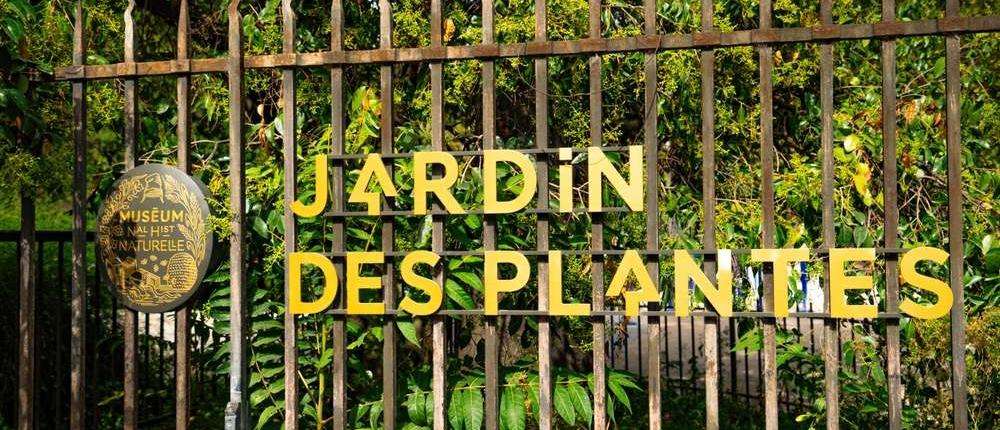The Jardin des Plantes in Paris 5: guided tour!
Posted in Hotel le 15 December 2023

After visiting the historic monuments and walking the streets of Paris, it is sometimes very pleasant to go green. For this, there is no need to go far, because the Jardin des Plantes is the ideal green space for walking, having fun and learning. Follow us for a guided tour of the Jardin des Plantes !
The history of the Jardin des Plantes de Paris
Created in 1635, the Royal Garden of Medicinal Plants was created following the request of the doctors of King Louis XIII, Jean Hérouard and Guy de la Brosse. The objective was then to cultivate all the plants that would make it possible to care for the king and his court.
The garden then quickly became a large-scale scientific organization , the oldest in France. Several courses are given there, on different themes, such as botany, natural history, and even chemistry. Many great botanists have also made their contribution, such as Lacépède, Jussieu, and the Becquerel brothers.
Under the reign of Louis XVI, the estate expanded thanks to the work of Buffon and Daubenton, and officially became a research center . In 1793, the garden was given the title of National Museum of Natural History . The objective is to continue to disseminate knowledge, to bring together the greatest scholars, and to exploit the research laboratory. This is, still today, the mission of the Jardin des Plantes.
Guided tour of the Jardin des Plantes
Spread over 24 hectares of greenery , the former King's garden is worth a short guided tour to make sure you don't miss anything of this elegant place in Paris 5.
The entrance to the garden
Several entrances provide access to the Parisian park, but to start the visit in the best conditions, we recommend that you go through Place Valhubert . As soon as you arrive, a perspective of more than 500 meters over the greenhouses and the Great Gallery of Evolution will immerse you in the charm and elegance of the park. As far as the Grande Galerie esplanade, you can admire flower beds and century-old trees , for an exotic walk in the heart of Paris.
You will be able to learn more about all the plants, thanks to the careful labeling, and if you are lucky enough to come in spring, the multi-colored flowers will dazzle you.
The school of botany
In the center of the garden, after walking along the ecological garden, you find the botanical school garden . There, more than 4,500 plants are classified by genera and families. The objective of the botany school at the Jardin des Plantes is to introduce botany enthusiasts, students, and even horticulturists to the study of plants capable of living in our climates .
As you walk along, your eye will probably be drawn to the 4 century-old trees in the park:
- The Judas Tree (1785);
- The Vélani oak (1814);
- The Corsican pine (1784);
- The Baronnies lime tree (1989), planted by President François Mitterrand, for the bicentenary of the French Revolution.
The alpine garden
Facing the garden of the botanical school, between the Grandes Serres and the Ménagerie, we notice the alpine garden . But how to access it? Many visitors get lost there, because the entrance is well hidden. You must, in fact, go to the middle of the botanical school garden, where a small underground path will guide you to the alpine garden. This is the only way to access this hidden garden! In fact, this small, less frequented park represents a true haven of peace where you feel privileged.
Created in 1930, this 4,000 m² space is dedicated to mountain and rock plants . More than 2,000 varieties from all four corners of the world are grown there: Caucasus, Pyrenees, Corsica, North America, Alps and Himalayas.
The Great Greenhouses
You then arrive at one of the most famous areas of the Jardin des Plantes: the Grandes Serres . There are 5 of them (4 of which are open to the public), and each one houses treasures.
- The tropical rainforest greenhouse (former winter garden): under the 16 meter high iron and glass structure, we find plants from hot and humid countries (banana trees, orchids, pandanus, ficus, palm trees... ) ;
- The greenhouse for deserts and arid environments (former colonial greenhouses): the colonial greenhouses, with their wooden structure, did not withstand the storm of 1999. They were replaced in 2010 by the greenhouse for deserts and arid environments, where the we find plant scenes from Mexico, the United States, the Andes, Madagascar...;
- The New Caledonian greenhouse (former Mexican greenhouse): housing succulent plants for a long time, this greenhouse is now dedicated to the flora of New Caledonia. Its educational aim reveals the issues of ecology, biodiversity and the fragility of ecosystems;
- The greenhouse of the history of plants (former Australian greenhouse): initially, this greenhouse housed New Caledonia and Oceania. Today, it aims to explain the development of flora, from the appearance of plants on Earth (430 million years ago) to today.
The menagerie of the Jardin des Plantes
You can continue your visit to the Jardin des Plantes by going to the park menagerie . Created in 1794 at the initiation of Bernardin de Saint-Pierre, the menagerie is one of the oldest zoological gardens in the world . There we found all the animals from the royal menagerie of Versailles, as well as all the animals which had been confiscated from the fairgrounds.
On more than 5 hectares, 500 birds, 240 mammals and 130 reptiles evolve before your eyes. If we immediately understand the fun and recreational aspect of the place, the primary function remains biological research and the study of the behavior and reproduction of endangered species.
The garden maze
Then pass in front of the Grand Amphitheater to go to the labyrinth of the Jardin des Plantes . In this slightly elevated park, you can wander along irregular paths at random. An ideal walk for romantic walkers, the labyrinth is enhanced by numerous evergreen plants and historic trees (Lebanese cedar, Cretan maple, Oriental thuja, etc.).
In the center, the Buffon gloriette is a small bronze pavilion which is part of history. It is, in fact, one of the oldest metallic architectural constructions in the world.
The Rose Garden
End your walk in the rose garden of the botanical garden . Facing the Geology Gallery, it houses more than 170 recent and ancient species. These thus retrace the history of the rose, the passion of horticulturists and the introduction to Europe of this romantic flower.
The other remarkable sites of the Jardin des Plantes
One day would not be enough to visit all the riches of the Jardin des Plantes . If you feel like it, you can also discover the Great Gallery of Evolution, the Gallery of Mineralogy and Geology, the garden of Iris and perennial plants, or the Gallery of Paleontology and Comparative Anatomy and the libraries of the Jardin des Plantes.
Useful information
The Jardin des Plantes is accessible free of charge every day , from 8 a.m. to 5:30 p.m. , even on public holidays.
From the Hôtel de l'Espérance , a 10-minute walk will be enough to reach the botanical garden, and a Vélib' station is available just 85 meters from the main entrance.
Good to know: access to the garden is free, but certain areas require a fee, such as the Grande Galerie de l'Évolution or the Ménagerie.
In the heart of the tumult of Paris, the Jardin des Plantes is a true haven of peace which allows you to learn more about the fauna and flora. From the Espérance hotel, this green space is also the ideal setting for a peaceful walk.
